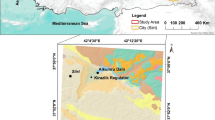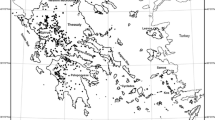Abstract
Massive landslides are rock and soil movement processes that have social, economic, and environmental impacts. Their study contributes to the balance of human settlements with the ecosystem and dynamics to mitigate and prevent risk. The intervention zone’s geomorphology, geology, precipitation, and geometry must be quantitatively considered to establish a susceptibility model. A methodology is proposed to analyze the susceptibility of mass removal with a 3D model built from aerial photogrammetry. The first step considers planning and executing a photogrammetric flight. Then, the photographic and topographic data are processed to generate a 3D model. At the same time, a map overlay is made from ortho mosaics, Digital Elevation Models, and layers. Finally, a model of transverse slope profiles is generated to determine the safety factor in San José de Maipo, Chile (33°38′S). The site presents traces and evidence of a landslide. Surface measurements of constructions, vegetation, and tension cracks were obtained. The main structural trends and depth of contact between bedrock and surface deposits detected are described. The generated models contribute to the susceptibility analysis by characterizing the landslide morphologies. Currently, it is possible to characterize undetectable removals only with Landsat imagery. The methodology is scalable to other geographic zones with geological evidence of rockslides, thus reducing uncertainty.
Access provided by Autonomous University of Puebla. Download conference paper PDF
Similar content being viewed by others
Keywords
1 Introduction
Integrating risks associated with geologic hazards in land-use planning can contribute to the proper design and construction of mitigation infrastructure for the community. For this, the characteristics of the mass removal processes and their impact on the ecosystem must be studied in depth. In addition, monitoring and prediction are required to determine the risk and avoid disasters that may impact human life, ecology, or economic losses (UNISDR, 2012).
The difficulty in predicting the occurrence of landslides today requires more information on areas prone to movement. Usually, these areas are often inaccessible, and conventional mapping can only record limited areas, whereas with Landsat imagery, the spatial resolution is much lower. The use of UAVs for photogrammetry allows capturing the terrain’s morphological characteristics and specific measurements of the parts that contribute to landslides.
2 Local Geological Settings
The area is in San José de Maipo in the mountain range of central Chile (33°38′S), with high slope and rainfall conditions, evidence, and susceptibility to landslides. The western slope of Divisadero hill was analyzed at the foot of which sanitary facilities and houses were exposed to this phenomenon. The slope has fluvial-alluvial deposits, volcanic rock units of the Abanico and Farellones formations, and a kilometer anticlinal fold with an NNW-NS orientation (Fock et al., 2006) (Fig. 1).
In particular, the western slope of Divisadero hill presents unstable material conditions (Sepúlveda et al., 2009, 2012), where the geometry of the landslide and the flow deposits of intense rainfall (1997 and 1999) caused severe damage to houses nearby. Due to this population’s high exposure and the health center at the foot of the slope, containment pits were built to mitigate the flow toward the settlement (Carrasco, 2000). A geomorphological map of the locality was built, which infers a reverse fault along the Cerro Divisadero, landslide scarps, and dejection cones in the area selected for this study (Alvarez Arriagada, 2006) determined the depth of the slope slip surface through electrical resistivity profiles.
A photogrammetric flight is proposed based on geomorphological evidence to measure escarpments, tension cracks, and other structures. In addition, we offered a susceptibility map using GIS map algebra based on susceptibility assessment (Mora Chinchilla, 2004), along with 2D and 3D analysis of geological and geometric characteristics to determine the level of slope stability.
3 Methodology
The literature describes the geological materials that make up the slope and their predominant geomorphological features. The way of acquiring the data and analyzing the 3D models and maps produced is shown in Fig. 2 and has 5 phases.
3.1 Flight Planning and Execution
The area delimited for the flight of the west slope of Divisadero Hill is represented by the yellow rectangular polygon in Fig. 2. The site is approximately 14 ha, with populated areas on an old river terrace to the west and Divisadero hill to the east. The aircraft used for photography is a DJI–Phantom 4. In addition, high-precision GNSS equipment is used to georeference the terrain by ground control points (GCP) with GNSS from Emlid–Reach RS+ as a base station and a second mobile antenna to capture a set of points within the flight area to deliver centimeter accuracy in three dimensions.
3.2 Process, Modeling and Analysis
Using Agisoft Metashape 1.5.1, photos and control points are loaded to generate the dense point cloud, digital terrain models (DTM), orthomosaics, and contour lines, with the USGS (2017) workflow. Then, with Leapfrog GEO 4.0, a geological model is generated with the modeled 3D data based on information from geological, geomorphological (Carrasco, 2000; Fock et al., 2006), photointerpretation, and geophysical (Alvarez Arriagada, 2006) maps to quantify the volume of the deposits associated with the main landslide. Subsequently, with Arcmap 10.5 software, the susceptibility maps are generated based on those developed by Mora-Vahrson (1994), considering the geomorphological factor to obtain the susceptibility. Once the geological model is generated in Leapfrog, cross sections of the relief in detail and the contacts of the rocks and deposits are exported and analyzed in Slope/W software considering the safety factor modeling of material and Bishop, Morgenstern-Price and Fellenius analysis for static and pseudo-static cases (Bishop, 1955).
4 Results
Map Analysis shows high susceptibility in the high slope areas, with flow marks and escarpments. In addition, moderate susceptibility of the rotational landslide area. From the 3D model of the deposits and stratified rocks, an approximate volume of material susceptible to movement of 53,000 m3 and containment volumes of 27,000 and 80,000 for the north and south containment pits, respectively, are obtained (Fig. 3).
5 Conclusions
The photogrammetric survey of Divisadero Hill achieved sufficient resolution and spatial accuracy to identify the essential morphological features of the main landslide, flow marks, and rockfall deposits. In addition, approximate structural features of the rock outcrops are distinguished. The integration of data with a resolution of fewer than 10 cm into a GIS results in a higher level of detail in the susceptibility map compared to one with satellite data. The analysis of the maps generated to determine susceptibility corroborates that geoforms such as scarps, tension cracks, and flow and rockfall deposits negatively affect the equilibrium on the slope, making it prone to landslides of different types.
The analysis of the slope profiles with 2D pseudo-static equilibrium modeling allowed the determination of a factor of safety (FS) in agreement with the in situ observations. On the other hand, the analysis of the 3D mesh associated with the geological model of the slope allowed the dimensioning of the existing deposits to estimate volumes prone to movement. Finally, the method can be applied to large areas and is therefore scalable to regional problems, providing greater detail with respect to the satellite photo interpretation method.
References
Alvarez Arriagada, M. A. (2006). Factibilidad de utilización de técnicas geofísicas en estudios de fenómenos de remoción en masa. Universidad de Chile.
Bishop, A. W. (1955). The use of the slip circle in the stability analysis of slopes. Geotechnique, 5, 7–17.
Carrasco, N. (2000). Peligro de remoción en masa en el sector de San José de Maipo. Departamento de Geología, Universidad de Chile.
Fock, A., Charrier, R., Maksaev, V., Farías, M., & Alvarez, P. (2006). Evolucion cenozoica de los Andes de Chile central (33°–34°S) (Vol. 2, pp. 205–207). XI Congreso Geológico Chileno.
Mora, S. Y., Vahrson, W. (1994). Macrozonation methodology for landslide hazard determination. Bulleting of the Association of Engineering and Geologist, 31(1), 49–58.
Sepúlveda, S. A., Rebolledo, S., Petley, D. N., Alvarez, M. & Schachter, P. (2009). Deslizamiento de San José de Maipo: Nuevos antecedents e implicancias en el peligro geológico (pp. 1–4). XII Congreso Geológico Chileno.
Sepúlveda, S. A., Rebolledo, S., Alfaro, A., Lara, M., Moffat, R., & Petley, D. (2012). Evaluación del peligro de remoción en masa en el deslizamiento de San José de Maipo, Chile central. SEREMI Metropolitana, Santiago.
UNISDR. (2012). Towards a Post-2015 framework for disaster risk reduction.
USGS National UAS Project Office: Agisoft Photoscan Workflow (2017).
Acknowledgements
This research was made under the project ANID PII180007 from the Chilean National Research Agency (ANID).
Author information
Authors and Affiliations
Corresponding author
Editor information
Editors and Affiliations
Rights and permissions
Copyright information
© 2023 The Author(s), under exclusive license to Springer Nature Switzerland AG
About this paper
Cite this paper
Villalobos, D. et al. (2023). Landslide Susceptibility Analysis Using 3D Modeling: A Case Study in San José de Maipo, Chile (33°38′S). In: Çiner, A., et al. Recent Research on Environmental Earth Sciences, Geomorphology, Soil Science, Paleoclimate, and Karst. MedGU 2021. Advances in Science, Technology & Innovation. Springer, Cham. https://doi.org/10.1007/978-3-031-42917-0_36
Download citation
DOI: https://doi.org/10.1007/978-3-031-42917-0_36
Published:
Publisher Name: Springer, Cham
Print ISBN: 978-3-031-42916-3
Online ISBN: 978-3-031-42917-0
eBook Packages: Earth and Environmental ScienceEarth and Environmental Science (R0)







